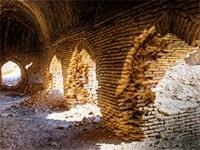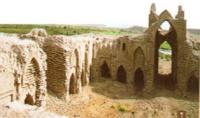You are here
Daya Khatyn caravanserai.




Tours on ancient caravanserais in Turkmenistan.
Tours on legends of ancient cities of Turkmenistan.
The Daya-Khatyn caravan sarai is located at an altitude of 232 meters above sea level, 1.3 kilometers from the left (western), main channel of the Amu Darya River, 2.1 kilometers to the east and slightly south of the Khalkabat railway station, 49.8 kilometers to the south and a little to the east of the village of Dargana, 148.3 kilometers northwest of the city of Turkmenabat in the Darganatyn etrap of the Lebap velayat.
Dayahatyn (also spelled Dayakhatyn or Daya-khatyn or Bai Khatyn in folk) is a medieval caravanserai, sitting on the left bank of Amu Darya. The Daya-Khatyn Caravanserai was built in the second half of the XIth century.
The architecture of this building, thanks to the style and construction details, represents an extraordinary example of the architectural art belonging to the Norten School of Khorasan of the Golden Age. Among settlements from Amul to Khoresm there are the ruins of the rabat with its caravan-serai Daya-khatyn.
In X c settlement Dargan was the significant feudal town destroyed by the army of Chengiz-khan. But at the end of XIII-in the middle of XIV the town still existed here. The Rabat Daya-khatyn represents (112 x 125) ruins of raw bricks (28 x 28 x 5,5 cm).
Round and rectangular walled towers fortified once rabat. Quadrate in plan caravan-serai (the length of it's side 53 m) stands at the center of Rabat. The arches, vaults and cupola of caravan-serai were made of burned bricks.
Preserved construction of brick vaults, console sails are of big interest. There were found relief fragments of texts with names of caliphs Abu-Bekir, Omar and Ali. Caravan-serai is a typical monument of architecture of Turkmenabat, Lebap Wilayah, near the border between Turkmenistanand Uzbekistan.
It is a fortified square enclosure with sides of 53 metres long. It was originally a fortress built by Tahir ibn Husayn in the IXth century. In the XIth century, it was transformed into a caravanserai with fascinating brick-structures, providing shelter for not only caravans but also elites during their long journeys.
The integrity of Dayahatyn acts as a typical example showing the mastering skill of Seljuk architects on brickworks during the XIth and XIIth centuries. Because of its artistic excellence, Dayahatyn is regarded as one of the most valuable and the finest example of caravanserai structure extant in the Central Asia.
There are several legends related to the construction of Dayahatyn. One of them is that the Rabat of Dayahatyn was built by a local ruler, who wished to hide from a beauty named Daya. Another version is about a rich man named Bai, who suspected his wife in infidelity and left home in the cloth of poor dervish.
His wife Bai-Hatyn waited him to return for many years. In order to ease his suspicion, she built this beautiful Dayahatyn to show her love and fidelity to her husband. After years of wandering, Bai finally came back to the homeland as a worker in the caravansarei construction.
Bai-Hatyn recognized him and they lived happily ever after. Based on the archaeological finds and historic records, it is believed that Dayahatyn was originally the Tahiriya fort. The construction of the Tahiriya fort (which is also spelled as Takhiria) is attributed to Tahir ibn Husayn, founder of the Tahirid dynasty, in the IXth century This kind of fortresses of army detachments, or simply called as “Rabat”, were used for military training of the Ghazi Warriors.
They studied the Koran and carried out military exercises and prayer offerings all within the fort. Because of the frequent international trading activities, large groups of people were travelling along the Silk Road. Caravanserais were built in every 25 - 35 kilometres in cities and deserts along the ancient Silk Road to provide a shelter for travellers.
As some areas are in the desolate steppes, walls and towers are needed to protect the coaching inn. Therefore, fortresses were sometimes transformed into caravanserais. In the XIth century, the Tahiriya fort was turned into a brick-caravanserai, which is the present Dayahatyn.
Dayahatyn caravanserai, with an adobe brick foundation and high-quality burnt brick structure on top, has a typical caravanserai- style square plan. It is enclosed by fortress walls of 53 metres long at each side with a round tower at each corner.
Two mutually perpendicular axes are marked by projections and arches in the inner yard and medium towers on the outer wall. Towers at the corners and at intervals along the curtain walls conveyed a powerful and forbidding impression.
The entrance on the eastern wall is also located on the perdencular axis and is stressed by a high arch portal. The rooms along its perimeter are separated by an arch gallery from the four-avian yard. There was also a mosque, an oblong hall to the right of the lobby.
This kind of plan structure and its spatial perception have been specified and developed in the architecture of the later Timurid epoch. At the stretches between the towers, there are symmetrically situated small rectangular towers excluding the pre-portal part.
By archaeological investigations, these fortress walls are found be the residues of Tahiriya fort of the IXth century, As the fortress changed its function into a caravanserai in the XIth century, the former fortress was being modernized during the XIth and XIIth centuries to meet the aesthetic of that time.
The walls, masonry of arches, roofs and domes were all built during that period. The way of decorating walls with plain bricks reflects a typical Seljuk style of the XIth and XIIth centuries. Decorative stucco moulding is applied in some places in the interiors.
Dayahatyn is centainly a masterpiece of the architect skill of the Northern Khorasan School of the “Golden Age”. On both sides of the entrance, the names of first successors to Prophet Mohammed (Ali, Omar, Osman and Abu Bakr) were found in kufic made by brickwork.
By mentioning the names of four important caliphs, Dayahatyn, certainly, was not simply a caravanserai for caravans. It was indeed also served as a royal stopover for elites during the long trips across the expanses of their powers Rooms with unusual layout and exceptionally inventive design are believed to be for the elites.
Between the names of the four caliphs, there were some empty frames with traces of a missing outer layer. The missing parts are believed to be with some inscriptions on the history of the building and be removed in the later time for unknown reasons.
Another reconstruction of Dayahatyn was held in the XVth and XVIth centuries. The high arched portal at the entrance was the product of that time. Its style is completely different from filigree brickwork of Seljuk period.
The portal, without any decoration, is also made of bricks but in a larger size and yet not as high quality as the one in the XIth and XIIth centuries. Along with the fall of the Silk Road, The Dayahatyn caravanserai lost its importance and was being abandoned.
Since then, the former coaching inn became the shelter of no longer caravans, but sometimes military units and rare wanderers passed by. The gorgeous structure was forgotten by the history. Not until the year of 1840, an officer of the East India Company rediscovered the buildings during his trip from Herat to Khiva.
He was the first European making a note on the caravanserai. In 1887, Leo Evgrafovich Dmitriev drew a picture of the caravanserai from the river side. Dayahatyn has its first photograph taken by Mikhail Chernyshevsky in 1899 and was first examined in 1920s by Alexander Marushchenko who laid the foundations of Turkmenistan archaeology.
The first detailed study of Dayahatyn was carried out in 1950 by Anna Maksimovna Pribytkova, an architectural historian. Later, her colleague Galina A. Pugachenkova wrote the most fundamental work on the architectural history of Turkmenistan.
She devotes many pages on the Dayahatyn and regards it as “a sample of the mature style, which requires a functional rationale, constructive feasibility and artistic excellence as an integral whole”. At its highest, there were thousands of different caravanserais scattered along the Silk Road.
However, most of them have been completely demolished and only the masterpieces, like Dayahatyn, are left along the Silk Road. Its artistic excellence makes Dayahatyn the most fascinating caravanserai in Turkmenistan. It represents the gorgeous brickwork of the XIth century.
It is also one of the most remarkable example of caravanserai architecture in Central Asia, along with Rabat-i Malik and Rabat-i Sharaf. These three caravanserais, with extraordinary artistic fineness, are believed to be the luxurious hotels along the Silk Road at that time.Among them, Dayahatyn retained its general contours to this day and has the highest integrity.
As the structural layout is simply symmetrical, the missing parts of the buildings and decorations could be restored easily without any speculation based on the existing remains. The complete structure of caravanserai could always be easily recreated.
Because of its architectural excellence and importance, Dayahatyn caravanserai is included in “The Analytic and Systematic Regional Inventory of Caravanserais in Central Asia”, organised by National Commission for UNESCO. Since 2002, Dayahatyn has been the subject of photographic surveys and drawing up of architectural documents.
Dayahatyn is also recommended for inclusion in the UNESCO World Heritage List because of its significance on the Silk Road. Since its rediscovery in the late 19th century, not much proper heritage management and protection had been done on Dayahatyn. Visiotrs' behaviours were not governed that carvings done by visitors could be seen on the walls.
Only in the recent years, conservation and management projects on Dayahatyn began to carry out. In 2012, Dayahatyn is awarded with a conservation grant from “Ambassadors Fund for Cultural Preservation” from the U.S. Government.
The conservation project would be administrated by the National administration for Protection, Research and Restoration of Historical and Cultural Monuments of Turkmenistan. The administration is also responsible for monitoring the regime for management and use of Dayahatyn caravanserai and coordinating relevant practical works, like archaeological surveys and rehabilitation.
As the Dayahatyn is located far from the common tourist routes and the movements of foreign visitors are still monitored by an extremely authoritarian government, the tourism development condition of Dayahatyn is not very favourable.
Very few tourists would be able to make a visit there. In order to develop the tourism, Dayahatyn caravanserai is included in “The Programme for tourism industry development in Turkmenistan in 2012 - 2016”. Within the programme, improvement works on tourism development in Dayahatyn would be carried out in the near future.
Geographic coordinates of Daya-Khatyn caravanserai: N40 ° 04'28.86 "E62 ° 23'55.57"
Authority:
https://en.wikipedia.org







